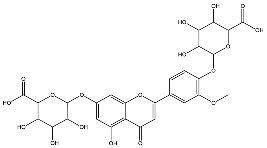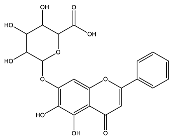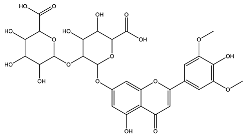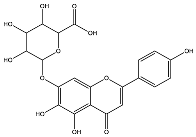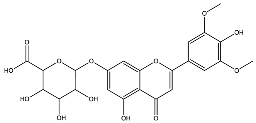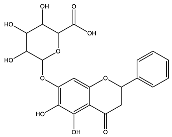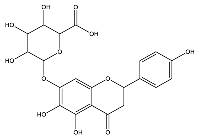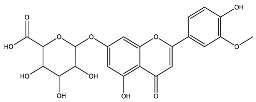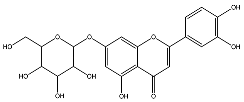Abstract
This study examined the relationship between flavonoid content and the antiviral effects of plant extracts against the dengue virus (DENV). Fourteen extracts from medicinal plants cultivated in Colombia, which were prepared by ultrasonic-assisted solvent extraction (UAE) and supercritical fluid extraction (SFE) were included. UHPLC/ESI-Q-Orbitrap-MS analysis identified forty-six flavonoids. Antiviral effect on viral adsorption was evaluated using the DENV-CPE-based assay. UAE extracts of Scutellaria coccinea, Scutellaria incarnata, and Lippia alba contained higher amounts of flavonoid glycosides (from 97.0% to 87.9%) than aglycones, and showed antiviral effect (IC50: 3.0 to 65 µg/mL; SI: 0.4 to 71). In contrast, UAE and SFE extracts from Lippia origanoides had higher content of flavonoid aglycones (41.7% to 93.4%) than glycosides (0.0 to 58.3%) and showed no antiviral effect. Cluster and one-way ANOVA analyses revealed a positive correlation between increased levels of flavone glycosides in the extract and a strong antiviral effect. Docking analyses (AutoDock Vina) revealed that the flavonoid glycosides exhibited a higher binding affinity for the target proteins (E, Gas6-Axl, clathrin, and dynamin) than the aglycones did. This study establishes a scientific basis for using extracts rich in flavonoid glycosides, particularly flavones, as starting points for developing plant-based therapies to treat dengue.
1. Introduction
Dengue virus (DENV) is transmitted to humans by Aedes species mosquitoes, which are prevalent in tropical and subtropical regions worldwide. There are four serotypes of the virus: DENV-1, -2, -3 and -4 []. DENV can cause a range of symptoms, from an asymptomatic infection to dengue fever and severe dengue shock syndrome. Dengue is highly prevalent in South and Southeast Asia, where it accounts for nearly 70% of the world’s cases. These regions are considered epicenters of the disease []. The Caribbean, Central America, and South America are also heavily affected. The number of dengue cases reported to the World Health Organization has increased over eight-fold in the last two decades, from 2.4 million in 2010 and 4.2 million in 2019 []. The reported deaths between 2000 and 2015 increased from 960 to 4032. According to the Pan American Health Organization, dengue fever increased significantly in the Americas in 2024 rising by 232% compared to 2023 and 421% compared to the average of the previous five years []. Dengue has been identified as a significant and persistent public health concern in Colombia, which is among the most affected countries in the Americas. From 2012 to 2020, annual incidence rate ranged from 90.7 to 476.2 per 100,000 population, with the most recent outbreak reported in 2019 (465.9 per 100,000 population) [].
There are currently no specific antiviral treatments for dengue, so therapy is primarily supportive []. Although two vaccines have been approved in some countries, their use is constrained due to safety concerns and their limited effectiveness against all DENV serotypes []. Dengue is a complex disease, making the discovery of effective therapies challenging. Increasing evidence suggests that herbal medicines have the potential as sources for clinical dengue treatments []. Administration of such medicines after virus exposure has shown to reduce the risk of severe dengue [,]. Thus, analyzing plant extracts has become an important strategy to discover and develop alternative therapies for dengue.
Plant-derived extracts prepared from a variety of species cultivated in different countries have demonstrated antiviral properties against human viruses, including DENV [,,]. Their antiviral effect varies according to the plant species, chemotype, and phenological stages. The chemical composition of plant extracts depends on both the species and the extraction technique used which, in turn, affects their antiviral activity [,]. Diverse secondary metabolites, especially phenolic compounds such as flavonoids, have shown the potential to inhibit a variety of human pathogenic viruses, including influenza H1N1, HIV, and Zika [,,]. Further research is necessary to fully elucidate chemical profiles that explain the anti-DENV activity of plant extracts. Studies demonstrate that plant-derived flavonoids have antiviral properties and can inhibit DENV by interfering with viral replication, entry, or specific viral proteins [,]. Several flavonoids derived from plants used in traditional medicine in Asia and Africa countries, such as quercetin, baicalin, baicalein, naringin, and catechin, have shown promising anti-DENV effects in vitro. Traditional Colombian herbal remedies are widely used to alleviate dengue symptoms, although few plants have been systematically studied for their therapeutic potential []. Research on the anti-DENV activity of plant extracts contributes to discovering alternative therapies to prevent severe dengue.
The genus Scutellaria (Lamiaceae) includes about 400 species widely distributed across America, Europe and Asia []. S. baicalensis is recognized as a promising natural source of compounds for treating viral diseases []. The genus Lippia (Verbenaceae) comprises 150 species, primarily found in the Americas, tropical Africa and India []. L. alba (Mill.) N.E. Brown was the first plant approved by the French Medicines Agency for inclusion in the French Pharmacopoeia []. L. origanoides Kunth was included in the Formulário de Fitoterápicos da Farmacopéia Brasileira due to its strong antibacterial properties []. L. alba and L. origanoides are traditionally used to treat viral infections such as influenza, measles and gastroenteritis [,]. Extracts prepared from S. baicalensis and L. origanoides have demonstrated inhibitory effect on the replication of DENV and other enveloped viruses [,]. We have investigated biological activities of both Lippia species and Scutellaria species cultivated in Colombia, and their extract chemical composition has been documented [,,,,]. This study investigated the in vitro anti-DENV activity and the influence of flavonoid content in fourteen extracts prepared three species of Scutellaria, two chemotypes of L. alba, and three chemotypes of L. origanoides from Colombia. Furthermore, in silico analyses were performed to hypothesize how the flavonoids in the extracts might interfere with the entry of DENV into Vero cells.
2. Results
2.1. Extracts
Fourteen extracts from five plant species were selected for the study: Scutellaria coccinea, Scutellaria incarnata, Scutellaria ventenatii × incarnata (hybrid), Lippia. alba, and Lippia origanoides. Eleven extracts were prepared using ultrasound-assisted extraction (UAE) at different temperatures (50 °C and 47 °C) and times (60, 23, and 15 min). Three extracts from L. origanoides were prepared using supercritical fluid extraction (SFE). The characteristics of the extracts are summarized in Table 1 and are categorized by plant species, chemotype, and extraction technique. The codes for the extracts are assigned based on the genus (first letter), species (second letter), and chemotype (third letter) of the plant; the extraction technique (UA or SFE) used; and the sample number (1 or 2). Eight UAE extracts were prepared in this study: SiUA-2, SviUA, LacUA, LaiUA, LopUA-2, LocUA-1, LocUA-2, and LotUA. The remaining six extracts were prepared and chemically characterized in previous studies [,,].

Table 1.
Extracts included in the study.
2.2. Cytotoxicity
Two different protocols of the crystal violet assay were used. One protocol determined the non-cytotoxic concentration of the extract to be used in the antiviral assay. This involved treating cells with extract for 1.5 h, which corresponded to the time allowed for viral replication. No cytotoxicity was observed for any of the extracts at concentrations ranging from 3.12 to 100 µg/mL (Figure 1A). The other protocol determined the 50% cytotoxicity concentration (CC50) of the extract by treating the cells for 72 h, in accordance with the standard test protocol for measuring the cytotoxicity of plant material (Figure 1B). Extracts from Scutellaria exhibited CC50 values ranging from 23 µg/mL to 213 µg/mL, for S. ventenatti + incarnata (SviUA) and S. coccinea (ScUA), respectively. Extracts from L. alba, LaiUA and LacUA, exhibited CC50 values of 65 µg/mL and 75 µg/mL, respectively. Six extracts from L. origanoides showed no cytotoxicity at the maximum concentration tested, suggesting CC50 values greater than 250 µg/mL; and the remaining two extracts from phellandrene (LopUA-2) and carvacrol (LocUA-2) chemotypes exhibited CC50 values of 117 µg/mL and 143 µg/mL, respectively.
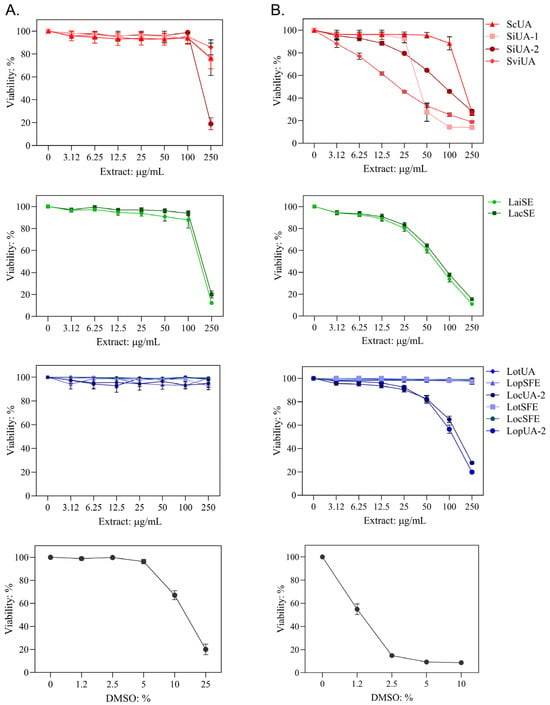
Figure 1.
Cytotoxicity of the extracts in the crystal violet assay. (A) Vero cells were treated with extract for 1.5 h and after washing the cell viability was measured five days later. (B) Cells were cultured in medium containing extract and the cell viability was measured 72 h later. Extracts from Scutellaria in red: S. coccinea (ScUA), S. incarnata (SiUA-1 and SiUA-2) and S. ventenatti + incarnata (SviUA). Extracts from L. alba chemotypes in green: carvone (LacUA) and citral (LaiUA) chemotypes. Extracts from L. origanoides chemotypes in blue: phellandrene (LopUA-2, LopSFE), carvacrol (LocUA-1, LocUA-2, LocSFE) and thymol (LotUA, LotSFE) chemotypes. LopUA-1 and LocUA-1 extracts were not included and their dose responses were comparable to those of LotSFE. Dimethyl sulfoxide (DMSO) was used as a cytotoxic agent. Data are presented as mean ± SD of six measurements from three independent analyses.
2.3. Antiviral Effect
Virus-induced cytopathic effect (CPE) is a surrogate measure of virus replication in vitro; therefore, lower DENV-induced CPE indicates stronger antiviral activity []. The extracts were tested at six nontoxic concentrations to evaluate their effect on CPE caused by DENV-1 and DENV-2 after treatment during virus adsorption to Vero cells. The presence of DENV in untreated cells was confirmed by detection of non-structural protein 1 (NS1 = 75 ± 1.97 PanBio units) using an ELISA kit. Antiviral effects were classified as: (i) strong, greater than 50% reduction in CPE of both virus serotypes with IC50 values lower than 55 µg/mL; (ii) weak, IC50 ≤ 55 µg/mL for only one serotype or IC50 between 55 and 100 µg/mL for one or both serotypes; and (iii) inactive, no significant CPE reduction in either serotype. Selectivity index (SI) was included in the analysis. An extract with IC50 ≤ 55 µg/mL and SI ≥ 3.0 was considered a promising anti-DENV sample. The extracts exhibited variable anti-DENV effect and selectivity (Figure 2 and Table 2).
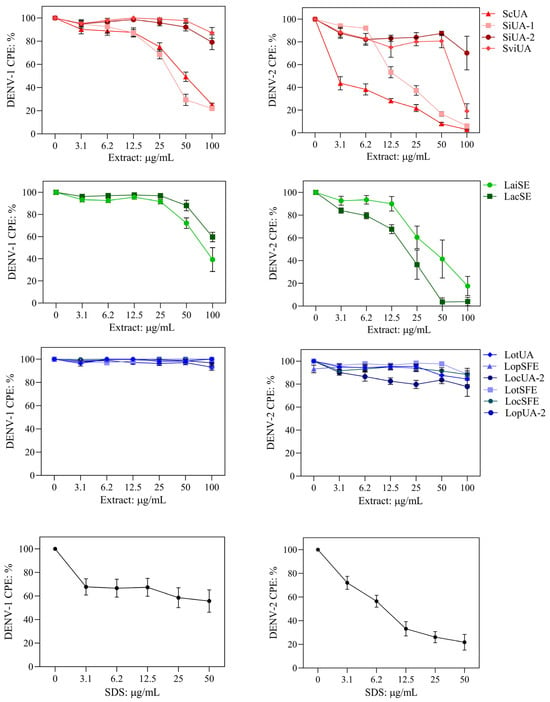
Figure 2.
Antiviral effect of the extracts against dengue virus (DENV-1 and DENV-2) in the cytopathic effect (CPE)-based assay. Extracts from species of Scutellaria (red), L. alba chemotypes (green) and L. origanoides chemotypes (blue) as described in Figure 1. Extracts were added during virus adsorption to Vero cells. Quantification of crystal violet staining was performed to indirectly measure virus-induced CPE. DENV-CPE %: [(OD570 of virus-infected and extract-treated cells/OD570 of non-infected non-treated cells].: Sodium dodecyl sulfate (SDS) is an antiviral agent. Data are presented as mean ± SD of six measurements from three independent analyses.

Table 2.
Antiviral effect of the extracts on DENV-infected Vero cells.
Extracts from S. coccinea (ScUA) and S. incarnata (SiUA-1) exhibited strong anti-DENV effect. ScUA showed IC50 values < 53 µg/mL and SI values > 4.0, indicating a promising anti-DENV sample. SiUA-1 showed IC50 values < 40 µg/mL, but SI values < 3.0, suggesting reduced antiviral promise. The other S. incarnata extract (SiUA-2) was inactive; significant reduction in the virus-induced CPE of both serotypes was not detected. The S. ventenatti + incarnata (SviUA) extract exhibited a weak antiviral effect, reduced DENV-2 at IC50 of 65 µg/mL (SI of 0.4), but not DENV-1. Extracts from L. alba exhibited weak antiviral effect. LaiUA (citral chemotype) reduced the replication of both virus serotypes, but at IC50 of 81 µg/mL against DENV-1. LacUA (carvone chemotype) showed antiviral promise against DENV-2 (IC50 of 19 µg/mL and SI of 3.9), but was inactive against DENV-1. All eight extracts from L. origanoides chemotypes were inactive against both virus serotypes.
2.4. UHPLC/ESI-Q-Orbitrap-MS Analysis of the Extracts Prepared in This Study
The analysis based on retention times (tR) and fragmentation patterns, identified only compounds belonging to the flavonoid class, including glycosides (n = 19), aglycones (n = 19) and methylated (n = 3) (Table 3 and Table 4).

Table 3.
Flavonoids in the extracts prepared in the study identified by UHPLC/ESI-Q-Orbitrap-MS.

Table 4.
Amounts (mg/g) of flavonoids in extracts prepared in the study.
Extracts from species of Scutellaria (UAE, 60 min at 50 °C) had higher concentrations of flavonoid glycosides than aglycones. Nine flavonoids were detected in S. incarnata (SiUA-2), with glycosides accounting for 64.7% (55–85 mg/g) of the total content. The predominant flavonoids were dihydrobaicalein-glucuronide, scutellarin, baicalin, baicalein, and wogonin. The flavonoid content of the S. ventenatti + S. incarnata (SviUA) extract was similar to that of SiUA-2, except for the absence of dihydrobaicalein-glucuronide and dihydrobaicalein. Flavonoid glycosides accounted for 55% (32/58 mg/g) of the SviUA content.
L. alba extracts (UAE, 60 min at 50 °C) had high flavonoid glycosides content, exceeding levels reported in extracts of the same species cultivated in Brazil [], which may be attributed to variations in extraction methodology and cultivation practice of the plant. In the LaiUA (citral chemotype) extract were identified eight flavonoid glycosides accounting for 90.7% (16.6/18.3 mg/g) of total content. Tricin-7-diglucuronide, chrysoeriol-7-diglucuronide, chrysoeriol-7-glucuronide, tricin-glucuronide, and apigenin-7-glucuronide were predominant. Seven flavonoid aglycones were also identified, five of which were below detection limits. The LacUA (carvonal chemotype) extract exhibited a comparable profile, yet with higher amounts of flavonoid glycosides (97.1%, 20.7/21.3 mg/g).
L. origanoides extracts had higher flavonoid aglycone content than the other test extracts. Notable differences were observed in extracts from the carvacrol chemotype. LocUA-1 (UAE, 23 min at 47 °C) contained twenty-four flavonoids, 82.3% (11.2/13.6 mg/g) of which were aglycones. Eriodictyol, naringenin, luteolin, quercetin, and cirsimaritin were predominant. The LocUA-2 extract (UAE, 60 min at 50 °C) contained twelve flavonoids in higher amounts (259 mg/g vs. 13.6 mg/g), with aglycones accounting for 41.7%. The predominant flavonoids were eriodictyol, eriodictyol-7-glucoside, and luteolin-7-glucoside. The thymol chemotype LotUA extract (UAE, 23 min at 47 °C) contained twenty-three flavonoids. Aglycones accounted for 73.1% (42/57.4 mg/g), with eriodictyol, quercetin, and naringenin as the predominant. The phellandrene chemotype LopSE2 (UAE, 60 min at 50 °C) extract contained fourteen flavonoids, with aglycones accounting for 61.5% (228/371 mg/g) with eriodictyol, pinocembrin, and galangin as the predominant.
2.5. Relationship Between Anti-DENV Effect and the Flavonoid Content
Fourteen extracts listed in Table 1 were included in the analysis. The chemical compositions of six extracts that were analyzed in previous studies are shown in Table S1. The relationship between antiviral effect and the flavonoid content was investigated to test the hypothesis that extracts exhibiting anti-DENV effect (strong or weak) possess distinct chemical profiles compared to inactive extracts. Table 5 compares flavonoid classes identified in the fourteen extracts.

Table 5.
Antiviral effect and relative concentrations of flavonoid classes of the extracts.
Extracts with the strongest anti-DENV effects (ScUA and SiUA-1) contained high amounts of flavonoids (277.8 mg/g and 492.9 mg/g, respectively). Of these flavonoids, 83.4% and 86.1%, respectively, corresponded to flavone glycosides, with baicalin, dihydrobaicalein-glucuronide, and scutellarin being the predominant flavones. ScUA and SiUA-1 also had small amounts of flavone aglycones, 10.3% and 5%, respectively. Additionally, the two extracts contained non-flavonoid compounds (6.4% and 10.5%), including verbascoside and umbelliferone-hexoside-pentoside (Table S1). In contrast, extracts with weak anti-DENV effects (SviUA, LacUA, and LaiUA) had significantly lower amounts of flavonoid (18.3 mg/g to 57.9 mg/g), though most of these were flavone glycosides (55.5% to 97% mg/g). Among the extracts with anti-DENV effect, SviUA contained a significantly higher concentration (44.5%) of flavonoid aglycones, all of them belonging to the flavone class. The S. incarnata SiUA-2 extract, lacking anti-DENV effect, had a chemical profile comparable to SviUA, except for the lack of dihydrobaicalein.
Extracts from L. origanoides lacking anti-DENV effect, except LopUA-1, had the lowest concentrations of flavone glycosides (0 to 24.7% vs. 64.8% to 97%) but the highest concentrations of aglycones (61.5% to 98.1% vs. 3.0% to 44.5%) compared to the other six extracts. The aglycones present were particularly flavanones and flavanols/flavanonols, which were absent in extracts that showed anti-DENV effects. Furthermore, UAE L. origanoides extracts exhibited higher levels of flavonoid glycosides non-flavones (14.7% to 52.7 vs. 0 to 4.6%), while SFE extracts lacked flavonoid glycosides and contained small amounts of methylated flavonoids. The LopUA-1 extract (phellandrene chemotype) had higher levels of flavonoid glycosides (77.6%) than aglycones (22%) compared to other L. origanoides extracts.
A Kohonen’s self-organized map algorithm, using percentages of flavonoid classes as input, grouped the fourteen extracts into two clusters (Figure 3A). Cluster 1 included five anti-DENV active extracts (Scutellaria and L. alba) along with the inactive S. incarnata extract (SiUA-2). These extracts shared the highest flavone glycosides content and lowest flavonoid aglycones. Cluster 2 grouped seven inactive L. origanoides extracts marked by elevated flavonoid aglycone levels. The LopUA-1 extract from L. origanoides was not included in cluster 2, as would have been expected, due to its distinct chemical profile. Figure 3B,C show that CPE values for DENV-1 and DENV-2 were significantly lower in cluster 1 compared to cluster 2 (Wilcoxon test, p < 0.01). This suggests a plausible relationship between the anti-DENV activity and a flavonoid profile characterized by a higher content of flavonoid glycosides, especially flavones, relative to flavonoid aglycones.
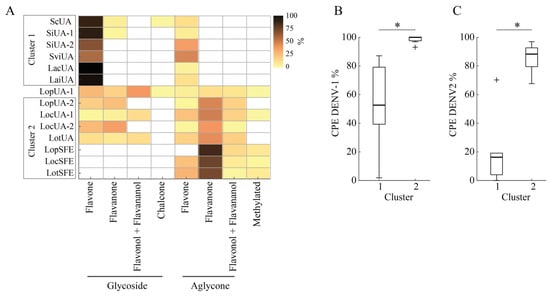
Figure 3.
Relationship between flavonoid profiles and anti-DENV effects of the extracts. (A) Heatmap showing the content of flavonoid classes and revealing two clusters obtained by an unsupervised self-organizing map. (B,C) Comparison of antiviral activity (CPE, cytopathic effect percentage) of clusters against DENV-1 (* Wilcoxon test Z = −2.969; p = 0.003) and DENV-2 (* Wilcoxon test Z = −2.785; p = 0.0053). “+” symbols denote individual mild outliers falling outside the whiskers.
2.6. Molecular Interactions Between Flavonoids and DENV and Vero Cell Proteins
DENV infection of Vero cells is initiated by the interaction between its envelope (E) protein and specific cell surface receptors, including Axl receptor tyrosine kinase []. The virus enters cells via a non-classical endocytic pathway mediated by the clathrin and dynamin proteins [,,]. To explore the role of flavonoids in the anti-DENV effect, an AutoDock Vina 1.5.6 software was used to dock forty-six flavonoids found in the fourteen extracts to the DENV-E, Gas6-Axl complex, clathrin, and dynamin. Binding energy values of ≤−7.55 kcal/mol indicate binding affinity between ligand and target. Figure 4 shows the relative concentrations of flavonoids in the extracts and their binding affinities to proteins. As expected, the analysis revealed varied binding affinities to targets. Generally, glycosides exhibited higher binding affinities (energy ranging from −10.22 to −8.01 kcal/mol) compared to aglycones (−8.23 to −7.90 kcal/mol), a difference that can be influenced by the presence of sugar. Most flavonoid glycosides exhibiting the lowest binding energies were the most abundant in extracts with anti-DENV effect.
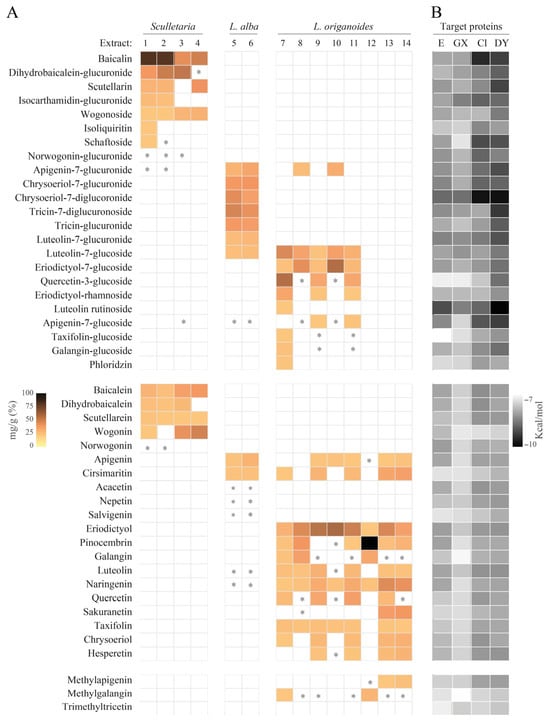
Figure 4.
Heatmaps showing the abundance of each flavonoid and its binding affinity for target proteins. (A) Relative concentration (mg/g) of flavonoid in the extract (Table 4): 1, ScUA; 2, SiUA-1; 3, SiUA-2; 4, SviUA; 5, LacUA; 6, LaiUA; 7, LopUA-1; 8, LopUA-2; 9, LocUA-1; 10, LocUA-2; 11, LotUA; 11, LopSFE; 12, LocSFE; and 13, LotSFE. Scutellaria (1,2 and 4) and L. alba (6 and 7) exhibited anti-DENV effect, while the other extracts were inactive. * Low detection limit. (B) Binding affinities (kcal/mol) of flavonoids for target proteins: E, DENV-2 E envelope; GX, Gas6-Axl receptor; Cl clathrin N-terminal domain (2XZG); DY, dynamin GTPase domain.
The DENV-E protein structure consists of three domains []. DI and DII domains form the DI/DII hinge region containing a conserved fusion loop. Conformational changes in this region lead to the fusion of the viral and cell endosomal membranes []. Nineteen glycosides (−9.16 to −7.72 kcal/mol) and fourteen aglycones (−8.06 to −7.55 kcal/mol) were predicted to bind to E. As for flavonoids found in extracts with antiviral effect, all flavone glycosides exhibited affinity (−8.78 to −7.72 kcal/mol) for E, except schaftoside. The lowest binding energies were exhibited by chrysoeriol-7-diglucuronide, chrysoeriol-7-glucuronide, luteolin-7-glucuronide, apigenin-7-glucuronide, and tricin-7-diglucuronide, all of which are predominant in L. alba extracts. All flavonoid aglycones, except cirsimaritin, exhibited affinity for E; the predominant baicalein, dihydrobaicalein, and apigenin showed the lowest energies (−7.96 to −7.84 kcal/mol). As for flavonoids present in extracts lacking antiviral effect (L. origanoides), 50% glycosides non-flavones (−8.08 to −7.73 kcal/mol) and 50% aglycones (−8.05 to −7.73 kcal/mol) exhibited affinity for E. Eriodyctiol-7-glucoside, eriodyctiol, and pinocembrin had the lowest binding energies. Flavonoids formed hydrogen bonds with amino acid residues at three consensus binding sites (Figure 5). Most glycosides were accommodated within the DII domain closer to the dimer interface (A/B), with the remaining glycosides located within the interface DIII/DI domains closer to the fusion loop. Most aglycones were accommodated within the detergent β-octyl glucoside (βOG) site in the hinge region, with the remaining aglycones located within the DII (A/B) interface.

Figure 5.
Contact preferences at the dimeric DENV-E protein (PDB ID: 1OAN) of representative flavonoids. The domains I, II and III of one monomer are colored red, yellow, and blue, respectively. Norwogonin (1) within the DI/DII hinge region around the βOG pocket; chrysoeriol-7-diglucoronide (2) within the interface of DII domains; and baicalin (3) within the DIII/DI interface. Binding free energies (kcal/mol) are shown.
DENV can bind to the Axl receptor via the Gas6 protein, which facilitates virus entry by bridging the viral envelope’s phosphatidylserine to Axl [,]. Gas6 has two domains (Lg1 and Lg2) that interact with Axl domains (Ig1 and Ig2). Sixteen flavonoid glycosides were predicted to bind to Gas6 (−8.66 to −7.56 kcal/mol), whereas no aglycones (−7.52 to −6.83 kcal/mol) exhibited binding affinity. All flavone glycosides found in anti-DENV extracts exhibited affinity (−8.69 to −7.56 kcal/mol) for Gas6, except for schaftoside. The lowest binding energies were exhibited by chrysoeriol-7-diglucuronide, tricin-7-diglucuronide, luteolin-7-glucuronide, and luteolin-7-glucoside. In contrast, only two (eriodyctiol-7-glucoside and eriodyctiol-rhamnoside) from six glycoside non-flavones found in inactive extracts were predicted to bind to Gas6 (−7.77 kcal/mol and −7.76 kcal/mol, respectively). Flavonoid glycosides formed hydrogen bonds with amino acid residues at five consensus binding sites (Figure 6). Most flavonoids were located within the Gas6-Lg2/Lg1 interface of each monomer. The remaining flavonoids were accommodated within the Gas6-Lg1 domain, and the Gas6-Lg1/Axl interface of each monomer.

Figure 6.
Contact preferences at the Gas6-Axl complex (PDB ID: 2C5D) of representative flavonoids. Gas6, Lg2 and Lg1 domains in blue and purple, respectively. Axl, Ig1 and Ig2 domains in gray. Isocarthamidin-glucuronide (1) and chrysoeriol-7-glucuronide (2) within the Gas6-Lg2/Lg1 interface; chrysoeriol-7-diglucuronide (3) within Gas6-Lg1 domain; tricin-7-diglucuronoside (4) within the Gas6-Lg1/Axl-Ig2 interface; and eriodyctiol-rhamnoside (5) within the Gas6-Lg1/Axl-Ig1 interface. Binding free energies (kcal/mol) are shown.
Dynamin possesses a GTPase domain that binds to and hydrolyzes guanosine-5′-triphosphate (GTP), causing a conformational change crucial for its function in DENV and cell membranes fusion []. Small molecules targeting GTPase can interfere with virus internalization [,]. All twenty-three flavonoid glycosides (−9.96 to −7.68 kcal/mol), except quercetin-3-glucoside, were predicted to bind to GTPase. The glycosides with the lowest binding energies were chrysoeriol-7-diglucuronide, baicalin, isoliquiritin, apigenin-7-glucoside, and chrysoeriol-7-glucuronide. These flavonoids are found in anti-DENV extracts but not in inactive L. origanoides extracts. Seventeen aglycones exhibited binding affinity for GTPase (−8.26 to −7.73 kcal/mol). Baicalein, dihydrobaicalein, luteolin, and scutellarein had the lowest binding energies. The flavonoids formed hydrogen bonds with amino acid residues of five consensus binding sites (Figure 7). Most glycosides were accommodated at the G4 loop extending to the switch1 loop (G4-switch1 loops), while others were accommodated within the P-loop and a few at the switch1 or switch2, closer to the P-loop (switch1-P-loops and switch2-P-loops). Most aglycones were accommodated at the switch2-P-loops and G4-switch1-loops.

Figure 7.
Contact preferences at the GTPase domain (PDB ID: 2X2E) of representative flavonoids. Chrysoeriol-7-diglucuronide (1) within the G4-switch1-loops; apigenin-7-glucoside (2) closer to the switch1-loop; luteolin-7-glucuronide (3) within switch1-P-loops; dihydrobaicalein-glucuronide (4) closer to the P-loop; isocarthamidin-glucuronide (5) within the switch2-P-loops; and tricin-glucuronide (6) within the switch1-loop. Binding free energies (kcal/mol) are shown.
Clathrin is a transport protein whose N-terminal domain (CTD) has various peptide-binding sites, including the PWDLW motif (W-box) []. CTD has been proposed as a target for antiviral agents that hinder viral entry into the cell []. All of the flavonoid glycosides were predicted (−10.01 to −8.08 kcal/mol) to bind to CTD, except for quercetin-3-glucoside. The lowest binding energies were observed for chrysoeriol-7-diglucuronide, triicin-7-diglucuronide, apigenin-7-glucoside, baicalin, and scutellarin. All flavonoid aglycones except wogonin exhibited binding affinity for CTD (−8.22 to −7.75 kcal/mol). Luteolin, eriodictyol, hesperetin, nepetin, and baicalein had the lowest binding energies. Both glycosides and aglycones formed hydrogen bonds with amino acid residues in the W-box motif (Figure 8).

Figure 8.
Contact preferences at the CTD-clathrin domain (PDB ID: 2XZG) of representative flavonoids. Chrysoeriol-7-diglucuronide (1), scutellarin (2), dihydrobaicalein-glucuronide (3), and wogonoside (4) within the W-box motif. Binding free energies (kcal/mol) are shown.
Molecular docking results for the predominant flavonoids of extracts from S. coccinea, S. incarnata, S. ventenatti + incarnata, and L. alba are shown in Table 6. Results for the other flavonoids are shown in Tables S1 and S2.

Table 6.
Binding mode predicted for the predominant flavonoids in extracts from S. coccinea, S. incarnata, S. ventenatti + incarnata, and L. alba to targets. Protein (PDB ID): Cl, clathrin N-terminal domain (2XZG); DENV-2 E, envelope (1OAN); DY, dynamin GTPase domain (2X2E); GX: Gas6-Axl receptor (2C5D).
3. Discussion
This study analyzed fourteen plant extracts from Scutellaria and Lippia species cultivated in Colombia that were prepared under varying experimental conditions. Analysis by UHPLC/ESI-Q-Orbitrap-MS revealed that flavonoids represented 95–100% of the content in all test extracts. UAE-extracts exhibited significant differences in their chemical profiles. Retention of flavonoid glycosides was greater with shorter extraction times (5 or 23 min) than with longer times (15 or 60 min). This trend was evident in comparisons between SiUA-1 vs. SiUA-2 as well as LopUA-1 vs. LopUA-2 extracts. The reduction in flavonoid glycosides by prolonged extraction is likely due to excessive sonication that facilitate thermal, oxidative, and mechanical degradation, which particularly affect thermolabile glycosides and phenolic compounds [,]. Time-dependent variation in the extraction process critically influences the chemical profiles, and ultimately, the abundance of bioactive compounds []. SFE is a highly efficient technique for extracting aglycone-rich fractions with limited recovery of water-soluble or glycosylated phytochemicals []. The SFE extracts of L. origanoides contained high levels of flavonoid aglycones and lacked glycosides, reflecting the principle that nonpolar CO2 extraction selectively enriches lipophilic compounds while excluding polar glycosides []. Chemical profiles of the extracts analyzed in this study differ from those reported for extracts of the same plant [,,,,,]. These variations can be explained by differences in growth stage and plant part, cultivation practice, and preparation technique.
The potential of crude plant extracts to inhibit DENV replication in vitro has been widely documented [,,]. However, relationships between their chemical composition and anti-DENV effect remain to be elucidated. This study integrates UHPLC/ESI-Q-Orbitrap-MS data with CPE-DENV reduction data showing that higher contents of flavonoid glycosides, predominantly flavones, correlate with greater inhibitory effect on DENV replication in Vero cells. Moreover, increased aglycones are associated with lack of antiviral action, as evidenced by the extracts from L. origanoides. The distinction between S. incarnata extracts is notable: SiSE1 showed strong antiviral effect, whereas SiSE2 had none. SiUA-2 contained lower flavonoid glycoside content (64.8% vs. 88.6%) and sevenfold higher aglycones (35.2% vs. 5.0%). In a previous study [], we compared the anti-DENV effects of LopUA-1 (77% glycosides) and LopSFE (no glycosides) extracts from L. origanoides. After treatment during DENV-1 adsorption on human hepatic cells, the level of viral NS1 protein was significantly reduced by LopSE1, but not by LopSFE. The flavonoid content is a determining factor in the antiviral action of plant extracts on viruses other than DENV [,]. Glycosylation may enhance flavonoid interactions with virus particles or cell surface receptors by increasing polarity or specific binding conformations relative to aglycones []. A study revealed that baicalin exhibited higher anti-DENV activity than baicalein in virus-infected cells []. Another study revealed that myricetin and its glycosides exhibited higher antiviral activity against HIV-1 virus compared to their aglycone counterparts [].
While mechanisms underlying plant extract antiviral activity are yet to be fully elucidated, flavonoids are widely accepted as primary agents [,]. Certain flavonoids can interfere with viral adsorption to host cells through the attachment and subsequent inhibition of proteins and molecules involved in the virus endocytosis [,]. We evaluated the potential of the extracts to interfere with the adsorption of the virus to cells. The reduction in DENV-induced CPE suggests that flavonoids may block molecular components that promote virus-cell membrane interactions, a possibility supported by the in silico analysis results. We selected the E protein of DENV, which plays an important role in the process that allows the virus to enter cells. Flavonoid glycosides from extracts with an antiviral effect exhibited the strongest affinity for the amino acids of the E DII domain, which interacts with receptors to promote viral entry into cells. Additionally, flavonoid aglycones bind to the βOG binding site of E, which has been established as a target for developing dengue antivirals []. Many flavonoids have been identified as DENV-E protein ligands [,].
DENV uses a variety of cell receptors to gain entry into Vero cells [,]. The Gas6-Axl complex was selected for the in silico analysis. Flavonoid glycosides from anti-DENV active extracts showed good binding affinities to Gas6, suggesting potential biological interference with this receptor, whereas none of the flavonoid aglycones bound effectively. Flavonoid glycosides may have prevented DENV virions from adhering to Vero cells by blocking the PtdSer-Gas6 binding step. Disrupting the PtdSer-Gas6-Axl complex has been proposed as a potential therapeutic approach to inhibit DENV replication []. Flavonoids may also have entered the cells and affected the expression of Gas6 and Axl. Luteolin can downregulate the expression of these proteins in human cells [].
Dynamin-dependent and clathrin-mediated endocytosis pathways are involved in DENV entry into Vero cells [,]. Targeting these pathways has been proposed as a strategy for developing antivirals [,]. The N-terminal domain (CTD) of clathrin and the GTPase domain of dynamin were selected for in silico analysis. Once again, flavonoid glycosides present in extracts with anti-DENV effect exhibited the best binding affinities with CTD and GTPase. Baicalein and scutellarin, which are abundant flavonoid aglycones in extracts from Scutellaria species, also showed good binding affinity to both proteins. The flavonoids may have destabilized the W-box domain of clathrin-CTD and reduced the capacity of dynamin to exchange GDP for GTP. The flavonoids may have affected the functionality of both proteins and consequently impacted the endocytosis process of DENV in Vero cells. Additionally, it is plausible that flavonoid treatment altered the fluidity of the viral envelope and cell membrane, affecting their fusion during endocytosis. Research has shown that flavonoids can increase the membrane fluidity by penetrating the hydrophobic bilayer core [].
4. Materials and Methods
4.1. Reagents
HPLC-grade acetonitrile, HPLC-grade formic acid (FA), isopropanol (98%), ammonium formate (AF, ≥99%), LC/MS-grade methanol, and potassium persulfate (≥98%) were obtained from Merck (Darmstadt, Germany). Standard substances, including apigenin-7-glucoside, baicalin, galangin, quercetin-3-glucoside, taxifolin, acacetin, baicalein, luteolin, naringenin, nepetin, quercetin, sakuranetin, and salvigenin, were purchased from Sigma-Aldrich (St. Louis, MO, USA), ChemFaces (Wuhan, China), and Phytolab GmbH (Vestenbergsgreuth, Bavaria, Germany). Type I water was obtained from a Millipore Direct-QTM (Merck, Darmstadt, Germany) purification system. Eagle’s Minimum Essential Medium (MEM), fetal bovine serum (FBS), phosphate-buffered saline (PBS), and antibiotics were purchased from Gibco (Grand Island, NY, USA).
4.2. Viruses and Cell
Vero cells (ATCC® CCL-81™), a monkey kidney epithelial cell line, were cultured in MEM supplemented with 100 units/mL penicillin-streptomycin mixture and 5% FBS, at 37 °C, in a 5% CO2 humidified incubator. BHK-21 cells (ATCC® CCL-10™), a hamster fibroblast cell line, were cultured in MEM as aforementioned. DENV-1 (US/Hawaii/1944 strain) and DENV-2 (New Guinea C strain) viruses were propagated and titrated in serial 1-log dilutions to obtain a 50% tissue culture infectious dose (TCID50) in BHK-21 cells grown in 96-well plates.
4.3. Vegetal Material
S. incarnata, S. ventenatti × incarnata, L. alba (citral and carvone chemotypes), and L. origanoides (phellandrene, carvacrol, and thymol chemotypes) were cultivated in experimental plots at the Agroindustrial Pilot Complex of the National Center for the Agroindustrialization of Aromatic and Medicinal Tropical Plants (CENIVAM), Industrial University of Santander (UIS), Bucaramanga, Colombia. The Colombian Ministry of Environment and Sustainable Development authorized the use of plant material through Contract No. 270 for Access to Genetic Resources and Derived Products, signed with UIS. Voucher specimens were deposited in the UIS Herbarium. The aerial parts of the plants (leaves and stems) were harvested from February to November in both 2021 and 2023. They were dried in the dark at room temperature until a constant weight was achieved. Subsequently, the plant material was ground using a SM 100 RETSCH® cutting mill (RETSCH®, Haan, Germany) equipped with a 2.00 mm square-hole sieve. The powdered material was stored at room temperature (25 °C) in the absence of light. The mass lost during drying was determined gravimetrically.
4.4. Extraction Technique
Ultrasound-assisted extraction was used to prepare eight of the aforementioned extracts, as previously described [,]. Briefly, 100 g of plant material was mixed with 20 mL of 70% ethanol and water solution and then placed in an ultrasonic bath (Elma® Elmasonic S15H, Singen, Germany). Extractions were conducted at 50 °C for 60 min, except for the L. origanoides thymol extract, which was conducted at 47 °C for 23 min (Table 1). The extracts were filtered using Whatman filter paper No. 1, after which the filtrate was extracted again with ethanol solution. The extracts were evaporated under vacuum using a Heidolph rotary evaporator, and then dried using a VirTis AdVantage Plus freeze dryer. Each extract (1 × 105 µg/mL) was dissolved in 1% DMSO and stored at −20 °C.
4.5. UHPLC/ESI-Q-Orbitrap-MS Analysis
Analyses were performed in accordance with the protocol used in a previous study []. Eight UAE extracts were analyzed using an Ultimate DionexTM 3000 UHPLC system (Thermo Fisher Scientific, Bremen, Germany) coupled to a Q-Exactive Plus Orbitrap™ mass spectrometer (Thermo Fisher Scientific, Bremen, Germany), equipped with a heated electrospray ionization source (HESI-II) operated in positive-ion acquisition mode. Phenolic compounds were separated using a ZORBAX Eclipse XDB-C18 column (Agilent Technologies, Palo Alto, CA, USA), 50 mm, L × 2.1 mm, I.D. × 1.8 μm particle size, at 40 °C. The mobile phase consisted of 0.2% formic acid in water (A) and 0.2% formic acid in acetonitrile (B), delivered at 0.3 mL/min. The gradient started at 100% A, shifted to 100% B over 8 min, held for 4 min, returned to 100% A in 1 min, and was equilibrated for 3 min. The injection volume was 2 µL. Extracts were analyzed in positive-ion mode under the following parameters: electrospray ionization temperature, 350 °C; capillary temperature, 320 °C; capillary voltage, 3.5 kV; mass range m/z 80–1000; and higher-energy collisional dissociation (HCD) cell, 10–40 eV range. Data were processed using Thermo Xcalibur™ Roadmap (v3.1.66.10). Metabolites were identified by comparing their retention times (tR), accurate masses, isotopic ratios, and fragmentation patterns with those of reference standards and database entries [,]. Quantitative analysis of flavonoids was performed using calibration curves prepared with analytical standards of apigenin-7-glucoside, baicalin, galangin, quercetin-3-glucoside, taxifolin, acacetin, baicalein, luteolin, naringenin, nepetin, quercetin, sakuranetin, and salvigenin. Quantification was based on the peak areas obtained from extracted ion chromatograms, and results were expressed as milligrams of compound per gram of freeze-dried extract (mg/g) or as equivalents to baicalin, galangin, taxifolin, or baicalein. The limits of detection (LOD) ranged from 0.05 to 1.10 mg/L, depending on the compound. All analyses were performed in triplicate, and results are presented as mean ± standard deviation (SD).
4.6. Cytotoxicity Test
The crystal violet assay was used to evaluate the effect of the extracts on the viability of non-DENV-infected Vero cells []. Each extract was examined at seven concentrations (3.12 to 250 µg/mL) and with different treatment times. (A) Cells grown in 96-well plates were incubated with extract for 1.5 h, washed with PBS, and fresh culture medium (MEM; 2% FBS) was added. The plates were then incubated at 37 °C with 5% CO2, and cell viability was measured five days later. (B) Cells grown in 96-well plates were incubated in culture medium containing extract at 37 °C with 5% CO2, and cell viability was measured 72 h later. In both assays, untreated cells and cells treated with DMSO were run in parallel as negative and positive controls, respectively. Cell viability was measured by discarding the culture supernatant and adding a crystal violet solution (0.05%), followed by methanol. The plates were analyzed using an ELISA plate reader at a wavelength of 570 nm. Non-cytotoxic concentrations for the cells and CC50 values were calculated using nonlinear regression analysis with the was performed using GraphPad Prism version 10.0 for Windows, GraphPad Software, Boston, MA USA, www.graphpad.com.
4.7. Cytopathic Effect (CPE)-Based Antiviral Assay
The CPE-based assay was used to evaluate the antiviral effect of the test extracts, as previously described []. Confluent Vero cells monolayers were infected by adding DENV-1 or DENV-2 at a multiplicity of infection of 1 p.f.u./cell for 1.5 h, and in the presence of non-cytotoxic concentrations (3.12 to 100 µg/mL) of extract. After washing with PBS, the cells were incubated in fresh medium (MEM; 2% SBF) at 37 °C and 5% CO2 for five days to allow for virus replication. Virus-infected cells in the absence of extract (negative control) and virus-infected cells in the presence of SDS (positive control) were included. Viral CPE reduction was determined by measuring cell viability using the aforementioned crystal violet assay. Results of the screening were expressed as a percentage of the reduction in DENV CPE [(OD570 of infected treated cells − OD570 of negative control)/(OD570 of positive control − OD570 of negative control) × 100]. The concentration of extract that inhibited DENV-CPE by 50% (IC50) was calculated using nonlinear regression analysis (GraphPad Prism version 10.0 for Windows). Selectivity index (SI = CC50/IC50) values were calculated. Each extract was analyzed in triplicate in three independent assays.
4.8. Molecular Docking Analysis
Docking analyses were carried out using AutoDock Vina (Version 1.5.6, La Jolla, CA, USA), as previously described [,]. The 3D crystal structures of target proteins were retrieved from Research Collaboratory for Structural Bioinformatics protein data bank RCSB PDB (rcsb.org accessed on September 2024): DENV-2 E (ID: 10AN), Gas6-Axl receptor (ID: 2C5D), clathrin CDT domain (ID: 2XZG), and dynamin GTPase domain (PDB ID: 2X2E). The protein structures were cleaned, water molecules removed, Gasteiger charges computed, polar hydrogens added, and non-polar hydrogens merged. The structures of 46 flavonoids were retrieved from the PubChem database (https://pubchem.ncbi.nlm.nih.gov/, accessed on 15 September 2024), Table 6 and Table S2 show structures and their CIDs. The preparation of ligands after the energy minimization step started with detecting and choosing the root atom. Optimized protein and ligand structures were saved in the PDBQT format. Default parameters were used, and the search exhaustiveness parameter was set to 100. For each ligand, 27 docked conformations were generated using global docking simulations. Three simulations were performed for each ligand-protein pair using seeds 6, 12, and 18. The Vina output including the docking scores (Kcal/mol), upper and lower bound root mean square deviation (RMSD), and the number of hydrogen bonds and interacting residues were used to examine the best-docked conformations in the individual run. Discovery Studio Visualizer v21.1.0.20298 was used to visualize interacting residues between ligand and protein for structural analysis.
4.9. Statistical Analysis
The relationship between antiviral activity and the flavonoid content was analyzed using two independent parameters: the chemical composition, represented as the absolute percentage (%) of different flavonoid classes (Table 5), and the antiviral effect, DENV-CPE (%) as a unidimensional variable ranging from 0 to 100. The extracts were clustered according to their flavonoid content using an unsupervised Kohonen self-organizing map (SOM) [], a type of unsupervised artificial neural network that groups samples by reducing the number of variables in the analysis, as previously described. Briefly, each extract was represented by a vector of chemical features and mapped onto a two-dimensional grid of ‘neurons’, where each neuron corresponds to a random vector of the same dimension as the input. During training, the algorithm identifies the neuron that most closely matches each extract vector based on distance metrics, then adjusts the weights of this and its neighboring neurons to further resemble the input. This process was repeated for 500 iterations, causing similar extracts to cluster near each other on the map, while more distinct samples separated into different regions of the grid. Consequently, extracts with similar chemical profiles cluster around the same neuron, whereas samples with dissimilar characteristics form distinct clusters. One-way ANOVA and Tukey–Kramer post hoc tests were used to compare DENV-CPE (%) values between clusters, adopting a significance level of 0.05. All analyses were performed using MATLAB® R2021b (The MathWorks, Inc. (Torrance, CA, USA)).
5. Conclusions
This study reports for the first time the correlation between the antiviral efficacy of extracts from medicinal plants cultivated in Colombia and their flavonoid content. Integration of antiviral assays, UHPLC analysis, and molecular docking analysis revealed that the content in flavonoid glycosides is a key determinant of the extracts’ anti-DENV effect. Extracts rich in flavonoid glycosides, particularly flavones, demonstrated the greatest antiviral efficacy. In contrast, extracts with lower levels of glycosides or lacking them did not show antiviral activity. Docking analysis suggests that the flavonoids present in the extracts could block the interaction between DENV particles and the cell membrane via different mechanisms. Based on IC50 and SI values from the CPE-based antiviral assay, the UAE extract from S. coccinea can be classified as a prospective anti-DENV sample. This extract contains high concentrations of flavonoid glycosides with potential to inhibit DENV, and therefore could serve as a starting point for research on herbal medications for dengue treatment. There is considerable evidence demonstrating the potential of plants from the Scutellaria genus as a source for developing an antiviral agent against various pathogenic viruses, including dengue virus (DENV).
Supplementary Materials
The following supporting information can be downloaded at: https://www.mdpi.com/article/10.3390/molecules30234566/s1, Table S1: Amount (mg/g) of compounds in extracts prepared in previous studies according to UHPLC/ESI-Q-Orbitrap-MS analysis. Table S2: Binding mode predicted for flavonoids found in the test extracts to targets. Proteins (PDB ID): Cl, clathrin N-terminal domain (2XZG); DENV-2 E, envelope (1OAN); DY, dynamin GTPase domain (2X2E); GX: Gas6-Axl receptor (2C5D).
Author Contributions
Conceptualization, R.E.O.; methodology S.A.V. and E.Q.-R.; chemical characterization, E.E.S. and L.J.S.; software and data curation, S.C.-O. and E.E.S.; writing—original draft preparation, R.E.O. and S.A.V.; writing—review and editing, E.E.S. All authors have read and agreed to the published version of the manuscript.
Funding
The authors thank funding from the Ministry of Science, Technology and Innovation, the Ministry of Education, the Ministry of Industry, Commerce and Tourism, and ICETEX, Programme Ecosistema Científico-Colombia Científica, from the Francisco José de Caldas Fund; Grant RCFP44842-212-2018.
Institutional Review Board Statement
The Ministry of Environment and Sustainable Development of Colombia supported the Universidad Industrial de Santander through the permit to access genetic resources and derivatives for bioprospecting (Contract No 270). The project RC-FP44842-212-2018 was approved by the Scientific Research Ethical Committee (Record No. 15-2017, File No. 4110) from Universidad Industrial de Santander. The experiments and the chemical management were performed according to national law (Resolution No 008430-1993) from the Ministry of Health of Colombia and the Institutional Manual of Integrated Management and Processes (PGOR-PGGA.05).
Informed Consent Statement
Not applicable.
Data Availability Statement
Data are contained within the article and Supplementary Material.
Conflicts of Interest
The authors declare no conflicts of interest.
References
- Wilder-Smith, A.; Ooi, E.E.; Horstick, O.; Wills, B. Dengue. Lancet 2019, 393, 350–363. [Google Scholar] [CrossRef]
- Zeng, Z.; Zhan, J.; Chen, L.; Chen, H.; Cheng, S. Global, regional, and national dengue burden from 1990 to 2017: A systematic analysis based on the global burden of disease study 2017. EClinicalMedicine 2021, 32, 100712. [Google Scholar] [CrossRef] [PubMed]
- Pan American Health Organization (PAHO). Dengue Epidemiological Situation in the Region of the Americas. Epidemiological Week 35, 2025. PAHO: Washington, DC, USA, 2025. Available online: https://www.paho.org/en/documents/dengue-epidemiological-situation-region-americas-epidemiological-week-35-2025 (accessed on 24 September 2025).
- Rodríguez-Morales, A.J.; López-Medina, E.; Arboleda, I.; Cardona-Ospina, J.A.; Castellanos, J.E.; Faccini-Martínez, Á.A.; Gallagher, E.; Hanley, R.; Lopez, P.; Mattar, S.; et al. The epidemiological impact of dengue in Colombia: A systematic review. Am. J. Trop. Med. Hyg. 2024, 112, 182–188. [Google Scholar] [CrossRef] [PubMed]
- Obi, J.O.; Gutiérrez-Barbosa, H.; Chua, J.V.; Deredge, D.J. Current trends and limitations in dengue antiviral research. Trop. Med. Infect. Dis. 2021, 30, 180. [Google Scholar] [CrossRef]
- Palanichamy Kala, M.; St John, A.L.; Rathore, A.P.S. Dengue: Update on clinically relevant therapeutic strategies and vaccines. Curr. Treat. Options Infect. Dis. 2023, 15, 27–52. [Google Scholar] [CrossRef]
- Rehman, B.; Ahmed, A.; Khan, S.; Saleem, N.; Naseer, F.; Ahmad, S. Exploring plant-based dengue therapeutics: From laboratory to clinic. Trop. Dis. Travel. Med. Vaccines 2024, 10, 23. [Google Scholar] [CrossRef]
- Rajapakse, S.; de Silva, N.L.; Weeratunga, P.; Rodrigo, C.; Sigera, C.; Fernando, S.D. Carica papaya extract in dengue: A systematic review and meta-analysis. BMC Complement. Altern. Med. 2019, 11, 265. [Google Scholar] [CrossRef]
- Adeosun, W.B.; Loots, D.T. Medicinal plants against viral infections: A review of metabolomics evidence for the antiviral properties and potentials in plant sources. Viruses 2024, 31, 218. [Google Scholar] [CrossRef]
- Zhao, L.; Qian, S.; Wang, X.; Si, T.; Xu, J.; Wang, Z.; Sun, Q.; Yang, Y.; Rong, R. UPLC-Q-Exactive/MS based analysis explore the correlation between components variations and anti-influenza virus effect of four quantified extracts of Chaihu Guizhi decoction. J. Ethnopharmacol. 2024, 319, 117318. [Google Scholar] [CrossRef]
- Zhou, J.; Yuan, X.; Li, L.; Zhang, T.; Wang, B. Comparison of different methods for extraction of Cinnamomi ramulus: Yield, chemical composition and in vitro antiviral activities. Nat. Prod. Res. 2017, 24, 2909–2913. [Google Scholar] [CrossRef]
- Badshah, S.L.; Faisal, S.; Muhammad, A.; Poulson, B.G.; Emwas, A.H.; Jaremko, M. Antiviral activities of flavonoids. Biomed. Pharmacother. 2021, 140, 111596. [Google Scholar] [CrossRef]
- Loaiza-Cano, V.; Monsalve-Escudero, L.M.; Filho, C.D.S.M.B.; Martinez-Gutierrez, M.; Sousa, D.P. Antiviral role of phenolic compounds against dengue virus: A Review. Biomolecules 2020, 24, 11. [Google Scholar] [CrossRef]
- Pájaro-González, Y.; Oliveros-Díaz, A.F.; Cabrera-Barraza, J.; Cerra-Dominguez, J.; Díaz-Castillo, F. Chapter 1—A review of medicinal plants used as antimicrobials in Colombia. In Medicinal Plants as Anti-Infectives; Chassagne, F., Ed.; Academic Press: New York, NY, USA, 2022; pp. 3–57. [Google Scholar]
- Shen, J.; Li, P.; Liu, S.; Liu, Q.; Li, Y.; Sun, Y.; He, C.; Xiao, P. Traditional uses, ten-years research progress on phytochemistry and pharmacology, and clinical studies of the genus Scutellaria. J. Ethnopharmacol. 2021, 265, 113198. [Google Scholar] [CrossRef] [PubMed]
- Huang, Q.; Wang, M.; Wang, M.; Lu, Y.; Wang, X.; Chen, X.; Yang, X.; Guo, H.; He, R.; Luo, Z. Scutellaria baicalensis: A promising natural source of antiviral compounds for the treatment of viral diseases. Chin. J. Nat. Med. 2023, 21, 563–575. [Google Scholar] [CrossRef] [PubMed]
- Atkins, S. Verbenaceae: The Families and Genera of Fowering Plants; Springer: Berlin, Germany, 2004; Volume 7, pp. 449–468. [Google Scholar]
- Pascual, M.E.; Slowing, K.; Carretero, E.; Mata, D.S.; Villar, A. Lippia: Traditional uses, chemistry and pharmacology: A review. J. Ethnopharmacol. 2001, 76, 201–214. [Google Scholar] [CrossRef]
- Hennebelle, T.; Sahpaz, S.; Joseph, H.; Bailleul, F. Ethnopharmacology of Lippia alba. J. Ethnopharmacol. 2008, 116, 211–222. [Google Scholar] [CrossRef] [PubMed]
- Oliveira, D.R.; Leitão, G.G.; Fernandes, P.D.; Leitã, S.G. Ethnopharmacological studies of Lippia origanoides. Rev. Bras. Farmacognosia. 2014, 24, 206–214. [Google Scholar] [CrossRef]
- Mamun-Or-Rashid, A.N.M.; Sen, M.K.; Jamal, M.A.H.M.; Nasrin, S. A comprehensive ethnopharmacological review on Lippia alba M. Int. J. Biomed. Mater. Res. 2013, 1, 14–20. [Google Scholar] [CrossRef]
- Zandi, K.; Lim, T.H.; Rahim, N.A.; Shu, M.H.; Teoh, B.T.; Sam, S.S.; Danlami, M.B.; Tan, K.K.; Abubakar, S. Extract of Scutellaria baicalensis inhibits dengue virus replication. BMC Complement. Altern. Med. 2013, 13, 91. [Google Scholar] [CrossRef]
- Quintero-Rueda, E.; Velandia, S.A.; Ocazionez, R.E.; Stashenko, E.E.; Rondón-Villarreal, P. Comparative anti-dengue activities of ethanolic and supercritical extracts of Lippia origanoides Kunth: In-vitro and in-silico analyses. Rec. Nat. Prod. 2023, 17, 878–895. [Google Scholar] [CrossRef]
- Arias, J.; Mejía, J.; Córdoba, Y.; Martínez, J.R.; Stashenko, E.E.; del Valle, J.M. Optimization of flavonoids extraction from Lippia graveolens and Lippia origanoides chemotypes with ethanol-modified supercritical CO2 after steam distillation. Ind. Crops. Prod. 2020, 146, 112170. [Google Scholar] [CrossRef]
- Porras, S.M.; Saavedra, R.A.; Sierra, L.J.; González, R.T.; Martínez, J.R.; Stashenko, E.E. Chemical characterization and determination of the antioxidant properties of phenolic compounds in three Scutellaria sp. plants grown in Colombia. Molecules 2023, 28, 3474. [Google Scholar] [CrossRef]
- Quintero, W.L.; Moreno, E.M.; Pinto, S.M.L.; Sanabria, S.M.; Stashenko, E.; García, L.T. Immunomodulatory, trypanocide, and antioxidant properties of essential oil fractions of Lippia alba (Verbenaceae). BMC Complement. Med. Ther. 2021, 21, 187. [Google Scholar] [CrossRef]
- Stashenko, E.E.; Martínez, J.R.; Cala, M.P.; Durán, D.C.; Caballero, D. Chromatographic and mass spectrometric characterization of essential oils and extracts from Lippia (Verbenaceae) aromatic plants. J. Sep. Sci. 2013, 36, 192–202. [Google Scholar] [CrossRef]
- Smee, D.F.; Hurst, B.L.; Evans, W.J.; Clyde, N.; Wright, S.; Peterson, C.; Jung, K.H.; Day, C.W. Evaluation of cell viability dyes in antiviral assays with RNA viruses that exhibit different cytopathogenic properties. J. Virol. Methods 2017, 246, 51–57. [Google Scholar] [CrossRef]
- Gomes, A.F.; Almeida, M.P.; Leite, M.F.; Schwaiger, S.; Stuppner, H.; Halabalaki, M.; Amaral, J.G.; David, J.M. Seasonal variation in the chemical composition of two chemotypes of Lippia alba. Food Chem. 2019, 273, 186–193. [Google Scholar] [CrossRef] [PubMed]
- The NIST Mass Spectrometry Data Center. The NIST Mass Spectrometry Data Center. The NIST Mass Spectral Search Program. In Standard Reference Data Program of the National Institute of Standards and Technology, USA; National Institute of Standards and Technology: Gaithersburg, MD, USA, 2017; p. 66. [Google Scholar]
- Lin, L.Z.; Mukhopadhyay, S.; Robbins, R.J.; Harnly, J.M. Identification and quantification of flavonoids of Mexican oregano (Lippia graveolens) by LC-DAD-ESI/MS analysis. J. Food Compos. Anal. 2007, 20, 361–369. [Google Scholar] [CrossRef] [PubMed]
- Timóteoa, P.; Kariotia, A.; Leitãob, S.G.; Vincieri, F.F.; Bilia, A.R. HPLC/DAD/ESI-MS Analysis of non-volatile constituents of three Brazilian chemotypes of Lippia alba (Mill.) NE Brown. Nat. Prod. Commun. 2008, 3, 2017–2020. [Google Scholar] [CrossRef]
- Parolin-Trindade, G.; Perez-Pinheiro, G.; Silva, A.A.R.; Porcari, A.M.; Sawaya, A.C.H.F. Sources of variation of the chemical composition of Lippia origanoides Kunth (Verbenaceae). Nat. Prod. Res. 2025, 11, 1–10. [Google Scholar] [CrossRef]
- Meertens, L.; Carnec, X.; Lecoin, M.P.; Ramdasi, R.; Guivel-Benhassine, F.; Lew, E.; Lemke, G.; Schwartz, O.; Amara, A. The TIM and TAM families of phosphatidylserine receptors mediate dengue virus entry. Cell Host Microbe 2012, 12, 544–557. [Google Scholar] [CrossRef]
- Cruz-Oliveira, C.; Freire, J.M.; Conceição, T.M.; Higa, L.M.; Castanho, M.A.; Da Poian, A.T. Receptors and routes of dengue virus entry into the host cells. FEMS Microbiol. Rev. 2015, 39, 155–170. [Google Scholar] [CrossRef]
- Piccini, L.E.; Castilla, V.; Damonte, E.B. Dengue-3 virus entry into vero cells: Role of clathrin-mediated endocytosis in the outcome of infection. PLoS ONE 2015, 10, e0140824. [Google Scholar] [CrossRef] [PubMed]
- Acosta, E.G.; Castilla, V.; Damonte, E.B. Alternative infectious entry pathways for dengue virus serotypes into mammalian cells. Cell Microbiol. 2009, 11, 1533–1549. [Google Scholar] [CrossRef] [PubMed]
- Zhang, X.; Jia, R.; Shen, H.; Wang, M.; Yin, Z.; Cheng, A. Structures and functions of the envelope glycoprotein in flavivirus infections. Viruses 2017, 9, 338. [Google Scholar] [CrossRef] [PubMed]
- Harper, C.B.; Popoff, M.R.; McCluskey, A.; Robinson, P.J.; Meunier, F.A. Targeting membrane trafficking in infection prophylaxis: Dynamin inhibitors. Trends Cell Biol. 2013, 23, 90–101. [Google Scholar] [CrossRef]
- Kirchhausen, T.; Owen, D.; Harrison, S.C. Molecular structure, function, and dynamics of clathrin-mediated membrane traffic. Cold Spring Harb. Perspect. Biol. 2014, 6, a016725. [Google Scholar] [CrossRef]
- Shen, L.; Pang, S.; Zhong, M.; Sun, Y.; Qayum, A.; Liu, Y.; Rashid, A.; Xu, B.; Liang, Q.; Ma, H.; et al. A comprehensive review of ultrasonic assisted extraction (UAE) for bioactive components: Principles, advantages, equipment, and combined technologies. Ultrason. Sonochem. 2023, 101, 106646. [Google Scholar] [CrossRef]
- Hou, M.; Hu, W.; Wang, A.; Xiu, Z.; Shi, Y.; Hao, K.; Sun, X.; Cao, D.; Lu, R.; Sun, J. Ultrasound-assisted extraction of total flavonoids from Pteris cretica L.: Process Optimization, HPLC Analysis, and Evaluation of Antioxidant Activity. Antioxidants 2019, 8, 425. [Google Scholar] [CrossRef]
- Uwineza, P.A.; Waśkiewicz, A. Recent advances in supercritical fluid extraction of natural bioactive compounds from natural plant materials. Molecules 2020, 25, 3847. [Google Scholar] [CrossRef]
- Xiao, J. Dietary flavonoid aglycones and their glycosides: Which show better biological significance? Crit. Rev. Food Sci. Nutr. 2017, 57, 1874–1905. [Google Scholar] [CrossRef]
- Moghaddam, E.; Teoh, B.T.; Sam, S.S.; Lani, R.; Hassandarvish, P.; Chik, Z.; Yueh, A.; Abubakar, S.; Zandi, K. Baicalin, a metabolite of baicalein with antiviral activity against dengue virus. Sci. Rep. 2014, 4, 5452. [Google Scholar] [CrossRef]
- Ortega, J.T.; Suárez, A.I.; Serrano, M.L.; Baptista, J.; Pujol, F.H.; Rangel, H.R. The role of the glycosyl moiety of myricetin derivatives in anti-HIV-1 activity in vitro. AIDS Res. Ther. 2017, 14, 57. [Google Scholar] [CrossRef]
- Pourfarzad, F.; Gheibi, N.; Namdar, P.; Gholamzadeh-Khoei, S.; Gheibi, N. Flavonoids antiviral effects: Focusing on entry inhibition of influenza and coronavirus. J. Inflamm. Dis. 2024, 28, e153347. [Google Scholar]
- Naresh, P.; Selvaraj, A.; Shyam Sundar, P.; Murugesan, S.; Sathianarayanan, S.; Namboori PK, K.; Jubie, S. Targeting a conserved pocket (n-octyl-β-D–glucoside) on the dengue virus envelope protein by small bioactive molecule inhibitors. J. Biomol. Struct. Dyn. 2022, 40, 4866–4878. [Google Scholar] [CrossRef] [PubMed]
- Waiba, A.; Phunyal, A.; Lamichhane, T.R.; Ghimire, M.P.; Nyaupane, H.; Phuyal, A.; Adhikari, A. Computational insights into flavonoids inhibition of dengue virus envelope protein: ADMET profiling, molecular docking, dynamics, PCA, and end-state free energy calculations. PLoS ONE 2025, 20, e0327862. [Google Scholar] [CrossRef] [PubMed]
- Li, X.; Chen, M.; Lei, X.; Huang, M.; Ye, W.; Zhang, R.; Zhang, D. Luteolin inhibits angiogenesis by blocking Gas6/Axl signaling pathway. Int. J. Oncol. 2017, 51, 677–685. [Google Scholar] [CrossRef] [PubMed]
- Ho, M.-R.; Tsai, T.-T.; Chen, C.-L.; Jhan, M.-K.; Tsai, C.-C.; Lee, Y.-C.; Chen, C.-H.; Lin, C.-F. Blockade of dengue virus infection and viral cytotoxicity in neuronal cells in vitro and in vivo by targeting endocytic pathways. Sci. Rep. 2017, 7, 6910. [Google Scholar] [CrossRef]
- Alkafaas, S.S.; Abdallah, A.M.; Ghosh, S.; Loutfy, S.A.; Elkafas, S.S.; Abdel-Fattah, N.F.; Hessien, M. Insight into the role of clathrin-mediated endocytosis inhibitors in SARS-CoV-2 infection. Rev. Med. Virol. 2023, 33, e2403. [Google Scholar] [CrossRef]
- Kapral-Piotrowska, J.; Strawa, J.W.; Jakimiuk, K.; Wiater, A.; Tomczyk, M.; Gruszecki, W.I.; Pawlikowska-Pawlęga, B. Investigation of the membrane localization and interaction of selected flavonoids by NMR and FTIR Spectroscopy. Int. J. Mol. Sci. 2023, 24, 15275. [Google Scholar] [CrossRef]
- Silva-Trujillo, L.; Quintero-Rueda, E.; Stashenko, E.E.; Conde-Ocazionez, S.; Rondón-Villarreal, P.; Ocazionez, R.E. Essential oils from Colombian plants: Antiviral potential against dengue virus based on chemical composition, In Vitro and In Silico Analyses. Molecules 2022, 27, 6844. [Google Scholar] [CrossRef]
- Parra-Acevedo, V.; Ocazionez, R.E.; Stashenko, E.E.; Silva-Trujillo, L.; Rondón-Villarreal, P. Comparative virucidal activities of essential oils and alcohol-based solutions against enveloped virus surrogates: In vitro and in silico analyses. Molecules 2023, 28, 4156. [Google Scholar] [CrossRef]
- Kohonen, T.; Somervuo, P. How to make large self-organizing maps for nonvectorial data. Neural Netw. 2002, 15, 945–952. [Google Scholar] [CrossRef]
Disclaimer/Publisher’s Note: The statements, opinions and data contained in all publications are solely those of the individual author(s) and contributor(s) and not of MDPI and/or the editor(s). MDPI and/or the editor(s) disclaim responsibility for any injury to people or property resulting from any ideas, methods, instructions or products referred to in the content. |
© 2025 by the authors. Licensee MDPI, Basel, Switzerland. This article is an open access article distributed under the terms and conditions of the Creative Commons Attribution (CC BY) license (https://creativecommons.org/licenses/by/4.0/).
